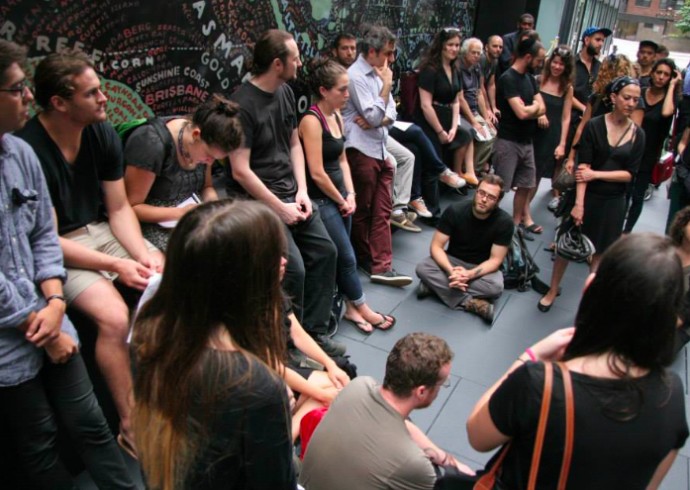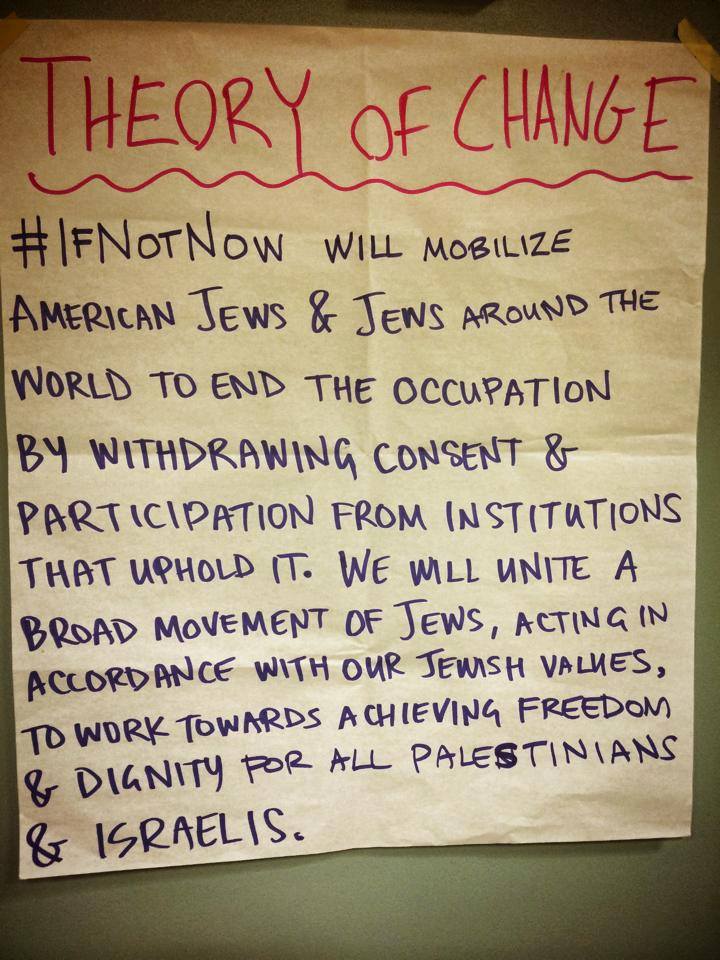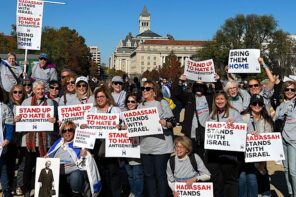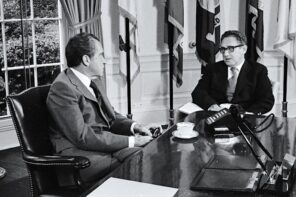Three weeks ago, a group of young American Jews gathered outside the New York offices of the Conference of Presidents of Major American Jewish Organizations, the umbrella organization founded in the 1950s and which claims to speak for a consensus of the American Jewish community. The young Jews outside, though, were challenging that organization’s claim to speak in their name. They read aloud the names of Palestinians and Israelis killed in the latest military escalation between Israel and Hamas in the Gaza Strip, and they recited the Mourner’s Kaddish.
A few days later, the group delivered a letter to the Conference’s CEO, Malcolm Hoenlein, demanding “that the Conference of Presidents join our call to stop the war on Gaza, end the occupation, and forge a path forward for freedom and dignity for all people in Israel and Palestine.” Nine activists were arrested for civil disobedience.
Hoenlein called the protest “very insignificant” and the protesters “Jewish kids who are misguided.”
Known as #IfNotNow (a use of the well-known words of the first century rabbinical sage Hillel), the group is made up of Jewish activists, some of whom are veterans of J Street, the inside-the-beltway advocacy group launched in 2008 that describes itself as “the political home for pro-Israel, pro-peace Americans.”
Carinne Luck, a former J Street chief of staff and vice-president for field and campaigns, who is part of #IfNotNow, said it is “not a direct response to or turning away from J Street,” but #IfNotNow’s existence “does speak to the lack of spaces in our community to take these actions and speak with this kind of voice.”
The rising tensions between the supporters of Israel’s use of military force and the dissenters has led to an unprecedented polarization in the American Jewish community as Operation Protective Edge continues without a permanent cease fire, much less visible prospects for the moribund peace process.
While #IfNotNow’s actions and protests thus far have been tiny—numbering in the hundreds—they are reflective of a burgeoning discontent with institutional Jewish reaction to the current Gaza conflict. That institutional reaction, these dissenters charge, not only unquestioningly supports the official Israeli narrative that Hamas left Israel no choice but to attack—and no choice but to target locations packed with civilians—but fails to acknowledge and address the ongoing violence and repression inherent in the occupation.
That institutional reaction, additionally, fails to reckon with countervailing evidence to the official Israeli narrative of the immediate causes of the current escalation. That includes evidence that the Israeli government knew the three Israeli students kidnapped in the West Bank in June had been murdered, but still ginned up emotions, in Israel and the diaspora, for a search the government knew was futile to find them alive. The Jewish Daily Forward’s J.J. Goldberg has meticulously documented the series of events leading up to an “unnecessary war” that “nobody wanted.” The government claim to be searching for the three kidnapped students, was, Goldberg wrote, “simply put, a lie.”
The institutional reaction, its critics further charge, fails to reckon with rising anti-Palestinian racism in Israeli government and society, or of military and police brutality against Palestinians, such as that brought down on Tariq Abu Khdeir, an American citizen and cousin of Mohammed Abu Khdeir, who was burned alive by Jewish Israeli citizens.
Increasingly, the American press is covering these societal and governmental trends, along with growing repression of left-wing and dissenting voices in Israel.
The current Israeli government, said Nathan Hersh, managing director of Partners for Progressive Israel, an American group allied with Israel’s liberal Meretz party, “is the further right government that I’ve seen in my lifetime.” Americans, he said, have become more conscious of “terribly racist” and “more blatant” comments tolerated by government officials. “That’s a driving force to the center and the left” among American Jews, he said.
The polarization of American Jews, said Dov Waxman, Professor of Political Science, International Affairs, and Israel Studies at Northeastern University, has increased with each large-scale eruption of fighting between Israel and Palestinians. Since the Second Intifada, which started in 2000, he said, with each escalation—Operation Cast Lead in 2009, Operation Pillar of Defense in 2012, and this summer’s Operation Protective Edge—there has been a shift of pro-two-state solution activists to the left; at the same time, though, the right becomes strengthened and entrenched.
J-Street Goes Mainstream, Its Left Flank Gets A Boost
On July 11, J Street released a statement supporting Operation Protective Edge, adding a list of additional statements that “too many communal and organizational reactions to the present crisis” fail to express, including grief over the loss of innocent Palestinian life, as well as condemnation of racist incitement of violence by both Palestinians and Israelis.
Rachel Lerner, J Street’s Senior Vice President for Community Relations, said that while the group did field some criticism over the decision, “we have a very diverse constituency, we were also hearing from folks who were very supportive of our stance and strongly urged us to express solidarity with Israel.”
“I think that certainly we provided a voice that was asking some questions in a very tense and difficult moment, questions that were very much lacking in the organized Jewish community,” said Lerner.
But that was not enough for many activists. Some J Street supporters were appalled by J Street’s failure to marshal opposition to this newest Israeli military campaign. “Are we moving the community or are we becoming part of it?” one activist asked.
J Street, said Waxman, “was a left-wing alternative to the groups in the center” when it launched in 2008, billing itself as a Washington-focused alternative to the American Israel Public Affairs Committee (AIPAC). Now, he said, “J Street has to some extent become part of the mainstream.”
Shaul Magid, a rabbi, the Jay and Jeanie Schottenstein Chair in Jewish Studies at Indiana University, and a regular contributor to RD, served on the J Street rabbinical council before resigning over the organization’s refusal to support the 2011 Palestinian bid to upgrade its status at the United Nations. He told me that someone once joked to him, “Everyone in J Street is to the left of J Street.”
The activist added that “a growing conversation on campus is feeding the growth of #IfNotNow,” representing a “growing desire by young people to hold Jewish organizational leaders to account,” and expressing that “these people who claim to represent the Jewish community as a whole do not represent them.”
J Street’s own campus arm, J Street U, has itself been home to that conversation. Danny Blinderman, a regional co-chair for J Street U’s New England region, charged in the New York Jewish Week that American Jewish communal leaders have failed to provide “meaningful support” for a two-state solution. “It is time for our leaders to rally around the cause of peace with at least as much fervor as they have around Israel’s latest war,” he wrote.
Simone Zimmerman, a former president of the National Student Board of J Street U, and an #IfNotNow organizer, said the group was motivated by “a sense of helplessness, seeing so many in the Jewish world completely filing in lock step in support” of Israel’s military action.
“So many folks felt called to [#IfNotNow] because they are Jewish,” said Zimmerman, adding that supporting the Israeli government’s action “is not my Judaism.”
The organizers prepared a statement called a “Theory of Change,” pledging that #IfNotNow “will mobilize American Jews and Jews around the world to end the occupation by withdrawing consent and participation from institutions that uphold it.”
Further left, previous military escalations in Gaza, said Waxman, historically have given a “huge boost” to Jewish Voice for Peace, a left-wing group founded in 1996, but widely seen as outside the mainstream of the Jewish community.
The scope and scale of civilian casualties in Operation Protective Edge, particularly of women and children—coupled with minute-by-minute coverage on social and traditional media by reporters on the ground for major news outlets—have intensified the opposition.
Jewish Voice for Peace, because of its rhetoric casting Israel as an aggressor, and because of its support for the Palestinian-led Boycott, Divestment, and Sanctions (BDS) movement, has largely been vilified by Jewish organizations as not representative of communal Jewish life.
The Anti-Defamation League has deemed the JVP “the leading Jewish anti-Zionist group in the United States, working to steer public support away from Israel and convince the American public that opposition to the Jewish state is not anti-Semitic”—a move seen even by those liberals who find JVP too far left as yet another instance of ADL’s attempts to marginalize Jewish groups who refuse to toe the party line.
Naomi Dann, a media fellow with JVP, said that the organization has seen a large uptick in new supporters and formation of local chapters since Operation Protective Edge, noting that in three weeks 50,000 new people signed up for its email updates. She said the ADL characterization is “deeply disturbing to us,” adding “we are part of the Jewish community, our values are rooted in Jewish values.”
Still, though, JVP may not fill a gap. Left-wing critics of J Street, which was once “the place to be,” Magid said, may not be comfortable with BDS, and thus not comfortable with JVP.
J Street, said Waxman, “actually does have a strong claim to represent a plurality of American Jews” with its opposition to the occupation and support for a two-state solution. Ultimately, though, he added, the greatest strategic damage to J Street will be the collapse of the peace talks led by Secretary of State John Kerry, and “growing despair over the two-state solution.” Without a viable political solution that is the centerpiece of J Street’s political agenda, he said, frustrated supporters of an end to the occupation will be drawn further to the left.
The center, said Magid, “hasn’t done any creative thinking in the last six or seven years.”
The Demise of Liberal Zionism?
Waxman has called this spring’s collapse of Kerry’s peace initiative “a bitter blow for liberal Zionists,” who now “must either abandon their liberalism or their Zionism, or just learn to live with the constant tension between them.”
Beinart now writes for Israel’s leading left-leaning newspaper Haaretz, where this summer he has repeatedly questioned Operation Protective Edge, both morally and strategically. In one column, a rejoinder to right-wing opponents who accuse him of being a Hamas sympathizer, Beinart argued, “Hamas does have unwitting allies among our people,” particularly “the Israeli and American Jewish leaders who convince Palestinians that nonviolence and mutual recognition are futile. They bolster Hamas’ greatest asset, which is not rockets and tunnels. Hamas’ greatest asset is the Palestinian belief that Israel only understands the language of force.”
Most frequently cited to me in conversations with activists over the past week, though, was New York magazine correspondent Jonathan Chait’s “Israel Is Making It Hard to Be Pro-Israel.” The Gaza operation, Chait wrote, “is not Netanyahu’s strategy in excess; it is Netanyahu’s strategy in its entirety.”
“The liberal Zionist, two-state vision with which I identify, which once commanded a mainstream position within Israeli political life,” Chait went on, “has been relegated to a left-wing rump within it.”
If you’ve lost Chait, the “pro-Israel” camp is in big trouble, reasoned pro-peace activists. Without a solution that ends the occupation and the second-class status of Israel’s Arab citizens, it will be increasingly difficult, if not impossible, to be a liberal Zionist.
The reality, though, is that these shifts have been taking place even before Chait issued his cri de couer—his prominence as a figure with unassailable “pro-Israel” credibility and a widely read platform merely brought them to the fore as photographs of dead Palestinian children and grieving families dominated newspaper front pages around the world.
Lisa Goldman, director of the Israel-Palestine Initiative at the New America Foundation, who worked for a decade as a journalist in Israel and the occupied territories, noted a growing and “real unease among a whole slew of male liberal Zionist columnists.” This shift, she said, has been developing over the past five years, as realities on the ground—including the daily brutality of the occupation and growing repression of left-wing dissent—have become more well-known.
These writers, said Goldman, are realizing “this isn’t quite what they told us [about Israel] in summer camp, and this doesn’t mesh with our humanist values.”
The horrific murder of Mohammed Abu Khdeir, a Palestinian teenager and resident of East Jerusalem, created an “opportunity for us to have a very serious conversation,” said Goldman. That the opportunity came and went, and discussion of rising racism and violence in Israel was swallowed by the push to “stand with Israel” when Operation Protective Edge began.
“I’m really afraid that Israel as an idea rather than Israel as reality has become such an essential totem that people are afraid to examine because it would mean reassessing their entire identity,” said Goldman. The failure to examine, she said, “is a moral failure, a tragedy.”
Benjamin Sax, a theologian and the Jewish Scholar at the Institute for Jewish and Christian Studies, said, “what’s missing in all of this is Judaism. People talk about Judaism and Jewish values, but strangely, the state of Israel has replaced that for liberal Jews,” who maintain a “romantic view of the state.”
In the last Gaza war, said Sax, there was discussion of Israel’s “noble military.” But in Operation Protective Edge, the military’s use of “warning” bombs and leaflets to alert Gazans to evacuate is starting to be increasingly seen “as either a form of hasbara”—Israeli public diplomacy, or “explaining”—“or psychological warfare and none of those things are worth defending.” This critique is not limited to academia; Jon Stewart has popularized it.
Questioning Hasbara and God
“When will American rabbis go beyond ‘feeling sympathy’ for the Gazans?” asked Charles Manekin, a philosopher and director of the Joseph and Rebecca Meyerhoff Center of Jewish Studies at the University of Maryland, who blogs under the pseudonym Jeremiah Haber.
In an interview from Jerusalem, Manekin criticized Americans who claim to support Israel, but spend little time educating themselves beyond “unquestioning adherence to the narrative of Israeli spokespeople.” (He strongly recommended reading Haaretz, not because of its political leanings, but because of its unvarnished and ongoing coverage of the realities of the occupation.) While American Jews may be critical of right wing Israeli groups and trends, he said, “when it comes to official Israel, it shows no skepticism.”
Rabbi Arik Ascherman, president and senior rabbi of the Jerusalem-based Rabbis for Human Rights, wrote this week, “my country’s attitude towards the killing of Palestinian civilians is deeply troubling.” (Israeli support for Operation Protective Edge exceeded 90% in polling.)
Many Israelis, Ascherman wrote, “deal with the contradiction between their unconditional support for the war and saying that they wish Gazans no harm by saying that they are heartbroken by the death of innocent civilians, but that Hamas is to blame” because it uses civilians as human shields. Some have even said civilians who voted for Hamas can be legitimate military targets.
Rabbi Rick Jacobs, president of the Union for Reform Judaism, the largest Jewish denomination in North America, told me the “overwhelming sense of our movement is support for Israel and [for] the military response in the face of these tunnels,” referring to the tunnels Hamas built from Gaza into Israel.
The URJ, along with the Conservative Movement and the Jewish Federations of North America, supported a “Stop The Sirens” campaign after Hamas rocket attacks “to raise and distribute funds to provide emergency aid and alleviate the pain and suffering of our Israeli brothers and sisters. At times such as these we especially feel connected to our people.”
At the same time, said Jacobs, there is a “deep sadness” for the death of Palestinian civilians. “The majority of Jews worldwide, and the overwhelming majority of our movement has been supportive of Israel, and at the same time not developing any casualness or callousness over the severity of the death toll of Palestinians.”
He added that he has seen no shift within the Reform movement of young people to a more radical position. Teen and young adult leaders in the movement, he said, are “supportive and understanding of Israel’s defense of her people” and “to do so honestly in ways that were simply mandatory if they were going to be responsible protectors of their people.”
While American rabbis have acknowledged disturbing trends in Israel, they frequently treat it as a fringe phenomenon they oppose. But Ascherman argued that respected religious figures in Israel are responsible for it. “Sadly,” he wrote, “some rabbis even desecrate God’s Name by sanctioning this unjustifiable equation of civilians with combatants.” He cited statements by influential rabbis, including Dov Lior, who “wrote two weeks ago that Israeli military commanders may punish Palestinian civilians and destroy Gaza entirely;” Shlomo Aviner, who “recently wrote on his Facebook page that while it is normally wrong to harm an innocent Arab for another’s sin, ‘war is war;’” and Yisrael Rosen, who “cites the 11thcentury Torah commentator Rashi on starving an enemy population to death, and advocates making Gazans suffer until they turn on Hamas.”
In expressing solidarity with Israel, American Jewish groups are supporting a populace that has largely lived in a bubble during the current conflict. Haaretz reporter Chemi Shalev has observed that during Operation Protective Edge Israelis “have been living in a parallel universe to most of the rest of the world,” shielded from the “ever-increasing doses of scenes of horrendous suffering in Gaza” seen in elsewhere, including the United States.
This poses risks for American Jews offering Israel that unquestioning support: that supporting the state has superseded supporting liberal values, and, more crucially, Jewish values, leading to a failure to reckon with the ways in which Israel’s current trajectory is an existential emergency. Rabbis, wrote Ascherman, “must not be cheerleaders for war’s logic.” Instead, “like Abraham, we must argue tenaciously with the powers-that-be. “






